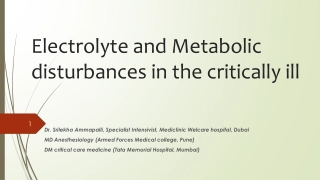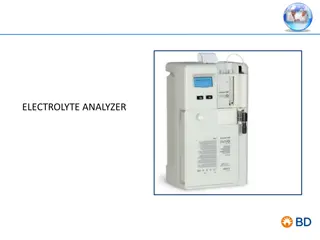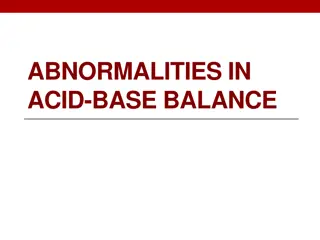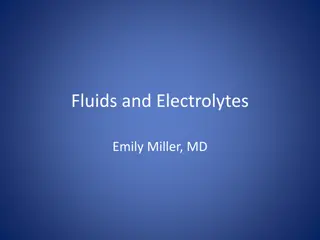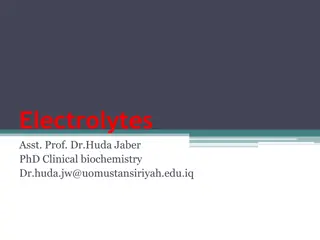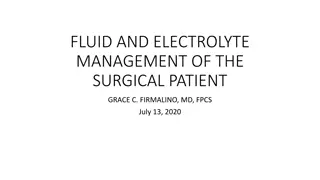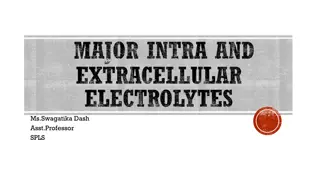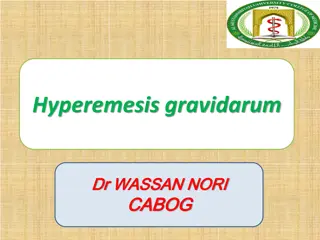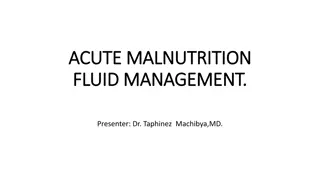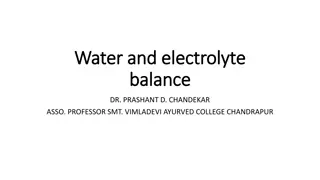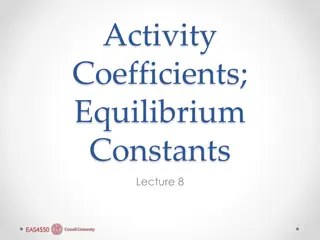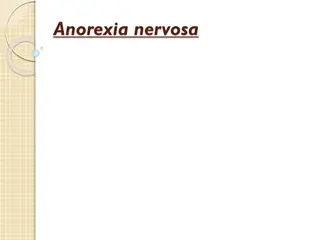Life-Threatening Electrolyte Imbalances
Abnormalities in electrolyte levels can indicate larger health issues. This content covers conditions, causes, diagnosis, and treatments of hyperkalemia, hypokalemia, hypernatremia, hyponatremia, hypercalcemia, hypocalcemia, hypermagnesemia, and hypomagnesemia. It also discusses acid-base imbalances and associated conditions like renal failure, medications, vomiting, and more.
Download Presentation

Please find below an Image/Link to download the presentation.
The content on the website is provided AS IS for your information and personal use only. It may not be sold, licensed, or shared on other websites without obtaining consent from the author.If you encounter any issues during the download, it is possible that the publisher has removed the file from their server.
You are allowed to download the files provided on this website for personal or commercial use, subject to the condition that they are used lawfully. All files are the property of their respective owners.
The content on the website is provided AS IS for your information and personal use only. It may not be sold, licensed, or shared on other websites without obtaining consent from the author.
E N D
Presentation Transcript
Electrolyte Abnormalities
Objectives Review conditions associated with life threatening electrolyte imbalances Review Hyperkalemia and Hypokalemia causes, diagnosis and treatment Review Hypernatremia and Hyponatremia causes, diagnosis, and treatment Review Hypercalcemia and Hypocalcemia causes, diagnosis, and treatment Review Hypermagnesemia and Hypomangnesemia causes, diagnosis and treatment Discuss life threatening acid-base inbalances
Introduction Identified abnormalities most likely represent only the TIP of THE ICEBERG . They are often a small indication of a much larger problem.
Conditions Associated with Electrolyte and Acid Base Problems Signs/Symptoms Acute Conditions Chronic Problems Renal Failure Medications Vomiting Drug Abuse Alcohol Abuse Acute Diarrhea/Constipation Metastatic Cancer Pancreatitis Immobilization Confusion, Lethargy, Irritability Poor intake Alcohol Abuse (Chronic) Hyperalimentation Weakness / Fatigue Seizures Malnutrition Surgery Nephrotic Syndrome Peritonitis Diabetes Overdose HTN Ketoacidosis Cirrhosis Respiratory Failure Heart Failure COPD Shock
Potassium MOST LIKELY TO BE LIFE THREATENING Potassium is critical for: NORMAL RANGE: Muscular Function Neurological Function 3.5 to 5 mEq/L Minor Changes Affect Conduction and Excitability of the Heart
Hyperkalemia One of the few lethal electrolyte disturbances Endogenous Causes Exogenous Causes Chronic Renal Failure MEDICATIONS: K sparing diuretics, ACE inhibitors, NSAIDS, Supplements, PCN, Beta Blockers, Succinylcholine Metabolic Acidosis (eg ketoacidosis) Chemotherapy causing tumor lysis Blood administration (older blood in particular) Rhabdomyolysis Hemolysis Diet (RARE) Hypoaldosteronism PSEUDOHYPERKALEMIA: WAS YOUR BLOOD SAMPLE HEMOLYZED?
Most common causes of hyperkalemia? Medications are the most common exogenous cause. Severe, life threatening hyperkalemia is most often caused by kidney failure. IN HOSPITAL: Most commonly caused by potassium supplements
Diagnosis Symptoms include: weakness, hypotension, and paresthesia ECG Findings as Potassium increases:
What is the highest K you ve ever seen?
Treatment Step 1: STOP supplementation and review medications Mild: 5 to 6 mEq/L Severe: 6.5 + with ECG changes Remove excess potassium from the body or cause temporary intracellular shift by: FIRST: give 5 to 10 ml of 10% calcium chloride IV over 5 minutes (Calcium will antagonize the toxic effects of potassium on myocardial cell membranes) Diuretics (Lasix 1mg/kg up to 80mg given slow IV) SECOND: Initiate a rapid shift of K into cells with glucose plus insulin and nebulized albuterol Resins such as Kayexalate Dialysis Glucose plus insulin 10 units R + 25 g glucose IV FINALLY: Begin removing excess K from body using methods previously mentioned. Nebulized albuterol (10 to 20mg over 15 minutes)
Hypokalemia: <3.5 Life threatening hypokalemia is rare Causes most commonly seen are Can cause arrythmia much like hyperkalemia, usually seen as U waves, flat T-waves, and ventricular arrythmias. Poor diet / malnutrition GI and sweat loss: vomiting, NG suctioning, diarrhea, malabsorption syndromes, heat stroke Often seen with hypomagnesemia Renal losses: Diuretics, aldosteronism Medications: Aminoglycosides, PCN, Cisplatin, Lithium, L-Dopa, Thallium, Theophyline
Diagnosis Mild 3.0-3.5: Often no symptoms 2.6% of hospitalized patients have significant hypokalemia (<3.0). These patients have a 21% mortality rate. Moderate 2.5-3.0: Generalized weakness, fatigue, constipation, leg cramps. Severe 2.0-2.5: Muscle breakdown, bowel obstruction Hospitalized patients often take diuretics. Stress hormones cause decrease in K+. Life threatening < 2.0: Ascending paralysis, impaired respiratory function, unstable arrythmieas
Treatment BOLUS POTASSIUM DURING CARDIAC ARREST IS NOT ADVISED Generally, for every 1 mEq/L deficit, the total body deficit is 150 to 400 mEq pH heavily affects serum potassium. K+ changes 0.3 mEdz for every 0.1 change in pH. Factor this into replacement Fast or Slow. In general oral is preferred at 20mEg/h dose. Oral or IV - Maximum IV concentration is 40mEq in 1 Liter of normal saline at a rate of 1000 ml/hr. MONITOR CONTINUOUSLY FOR IV THERAPY. Do not infuse through central line if the tip of catheter is in the right atrium.
In General ACUTE CHANGES PRODUCE FREE WATER SHIFTS INTO AND OUT OF VASCULAR SPACE An acute drop in serum sodium will shift water out of vascular space and into interstitial space (can cause cerebral edema) An acute rise will shift water into the vascular space Rapid correction of hyponatremia is associated with rhabdomyolysis and cerebral bleeding As total sodium increases, extracellular fluid increases, resulting in fluid volume overload (CHF, Liver failure, nephrotic syndrome). When total sodium content decreases, ECF volume decreases (volume depletion). Causes orthostatic hypotension, tachycardia, etc. Unlikely to be cause of severe cardiac instability Most impactful on serum osmolality. Severe increase in sodium = severe increase in serum osmolality. Abnormalities often reflect total body water abnormalities Usually levels controlled by the renin- angiotensin-aldosterone system and with ADH. Sodium is an extracellular ion primarily.
Hypernatremia Normal range: 135 145 mEq/L Causes: Generally 1 of 3 mechanisms Insufficient water intake 1. Loss of water and sodium (but more water than sodium lost) 2. Excess gain of sodium 3.
Hypernatremia Diagnosis and Treatment Treatment of hypernatremia: Correct underlying cause and correct water deficit if present. Diagnosis: Remember that high sodium levels cause shift in fluids from interstitial space to vascular space Replace water lost is focus. NOT removing excess sodium Minor Symptoms: Nausea, Vomiting, Fatigue, Irritability Fluid replacement is generally indicated. Use normal saline or equivalent. Water solutions (D5W) reduce concentrations to quickly. Severe: Confusion, Coma, Seizures, Muscle Weakness, Ataxia Total body water is 50% of lean body weight (Total body water = .5 x kg Emergent intervention: 500ml fluid bolus every 20 minutes until stable
Hyponatremia Represents excess water in relation to sodium Causes: Generally caused by decreased renal excretion of water OR by loss of sodium
Hyponatremia Treatment Use a stepwise approach: Assess intravascular volume (hypervolemic [edematous states], hypovolemic, or normovolemic) Treat based on severity of symptoms and volume status 1. 2. Hypovolemic treat with normal saline Hypervolemic treat by fluid restriction, diuresis with furosemide Normal volume status (SIADH) restrict fluid volume and treat underlying cause About 3% Saline
Calcium Normal total calcium: 8.5 to 10.5 mg/dL - Normal ionized calcium: 4.2 to 4.8 mg/dL Half of all calcium is bound to albumin Most abundant mineral in the body. Half of all calcium is biologically active in its ionized form. Many processes depend on intracellular calcium such as enzymatic reactions, muscle contraction, cardiac contractility, and platelet aggregation. Essential for bone strength and neuromuscular function. Albumin concentration affects serum calcium levels Ask for lab that includes both if signs of hypocalcemia
Hypercalcemia Fairly common (up to 6% of population). Over 90% caused by malignancy or hyperparathyroidism.
Diagnosis Stones, Bones, Moans and Groans, and Psychologic Overtones Stones: Renal lithiasis Bones: Osteolysis releasing calcium (metastatic disease) Moans and Groans: Generalized abdominal pain, peptic ulcers Psychologic Overtones: Apathy, depression, stupor, coma, irritability, hallucinations Levels greater than 15mg/dL for total calcium may cause cardiac symptoms. AV block can progress to a complete heart block.
If rapid decrease in calcium is needed Hemodialysis is the treatment of choice.
Hypocalcemia Relatively rare. Most frequent causes are pancreatitis, Vitamin D deficiency, and medications.
Diagnosis and Treatment Usually asymptomatic. Symptoms usually occur when levels of ionized calcium fall below 2.5 mg/dL Treatment: Give Calcium Paresthesia of extremities Calcium chloride (10%) 5 to 10 mL Muscle cramps, carpopedal spasms, stridor, tetany, seizures, coma. Calcium gluconate (10%) 15 to 30 mL IV over 5 minutes Hyperreflexia and positive Chvostek sign (tap over facial nerve in front of ear produces a twitch in eyelid or mouth) USUALLY HAVE TO CORRECT ABNORMALITIES IN MAGNESIUM AND POTASSIUM ECG changes include prolonged QT, T wave inversion , bradycardia, AV block and V-tach
Magnesium Fourth most common mineral and second most abundant intracellular cation Necessary for movement of sodium, potassium, and calcium in and out of cells. Low potassium and low magnesium is a combination for severe arrhythmias Most magnesium is in bone or bound to albumin, so lab draws for magnesium levels don t reliably reflect total body magnesium.
Hypermagnesemia Causes and Diagnosis Rare. Almost always associated with renal failure. Symptoms relate to severity: 3 to 4 mEq/L: Neuromuscular irritability, somnolence, and loss of DTR 4 to 5: Severe muscle weakness 5 to 8: Vasodilation and Hypotension 8 mEq/L or higher: Cardiac conduction problems, neuromuscular paralysis, hypotension, ventilation failure, and cardiac arrest
Treatment Stop giving Magnesium! 1. Dialysis is ultimate treatment 2. Stop giving magnesium and support ABCs. Treated initially with calcium which removes magnesium from serum 3. Dilute serum levels with normal saline. 4. Antagonize effects with calcium. May have to support cardiorespiratory function 5. Remove excess magnesium with diuretic (furosemide 1mg/kg up to 80 mg) Magnesium bolus is used frequently in obstetrics. In case of overdose calcium administration may be lifesaving intervention.
Hypomagnesemia More common than hypermagnesemia Interferes with the effects of PTH and results in hypocalcemia. Can also lead to hypokalemia.
Causes and Diagnosis Occurs in 11% of all hospitalized patients and 65% of severely ill patients. Mostly asymptomatic If any symptoms, usually muscular tremors, altered mentation, vertigo, ataxia If severe can cause tetany and seizures Usually associated with alterations in potassium and calcium
Treatment of Hypomagnesemia Treatment depends on severity. Replace cautiously as significant possibility of life threatening hypermagnesemia. Mild: Oral replacement is preferred. Give Magnesium oxide 400 mg BID Moderate: give Mag Sulfate 1 2 grams over 15 minutes, then 6 grams over 24 hours. MONITOR DTR s. May take days to see correction. Severe: Give 2 grams over 15 minutes, then 6 grams every 24 hours for up to 7 days. Check mag levels daily and monitor DTR s.


